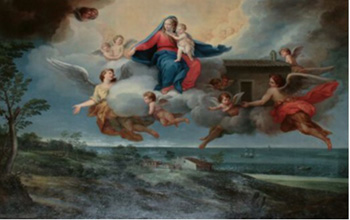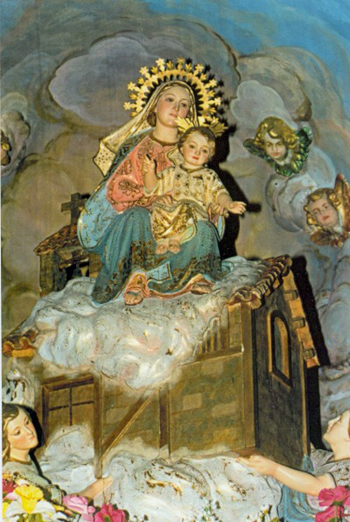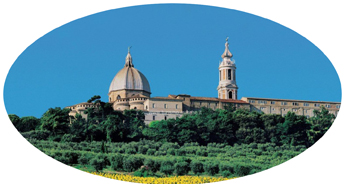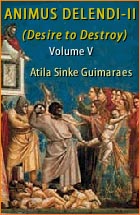Traditionalist Issues
 |
 |
 |
 |
 |
 |
 |
Dialogue Mass - XCII
The Feast of the Translation of the
Holy House Suppressed
“To us, Nazareth and its Holy House, exiled, wandering, angel-borne, Syrian, Dalmatian, Italian, all by turns, are consecrated places, doubly consecrated by their old memories, and also by their strange continued life of local graces, and the efficacious balm of a Divine
Presence, awful and undecayed.” (1)

 To the uninitiated, that is, those who are not familiar with the Nazareth-Loreto history of the Holy House, these words must appear as a conundrum in need of explanation. They were written in 1860 by the Oratorian priest, Fr. Frederick Faber, who had consecrated himself to Our Lady during a pilgrimage to Loreto in 1846. (2)
To the uninitiated, that is, those who are not familiar with the Nazareth-Loreto history of the Holy House, these words must appear as a conundrum in need of explanation. They were written in 1860 by the Oratorian priest, Fr. Frederick Faber, who had consecrated himself to Our Lady during a pilgrimage to Loreto in 1846. (2)
In this charming vignette written in his customary poetic style, he encapsulates the whole history of the Translation of the Holy House of Nazareth and the trajectory it followed to its present resting place in Italy, while also conveying a sense beyond the literal.
All the essentials are neatly summed up in Fr. Faber’s potted history of the Holy House:
It is a remarkable fact that, after 7 centuries of belief in the miraculous translation of the Holy House of Loreto, most Catholics today have reverted to the Protestant tradition of regarding such miracles as “superstitious fables.” They now dismiss what they facetiously call the “flying house of Loreto” as the stuff of fairy tales.
 Such skepticism was never endemic to the Catholic Church until the infiltration of the Modernist Movement in the late 19th century. Its proponents, who denied the reality of the supernatural, misled many of the faithful into believing God cannot intervene in our world and produce miracles. Thus, they impugned the authenticity of relics or any physical manifestation of Divine intervention.
Such skepticism was never endemic to the Catholic Church until the infiltration of the Modernist Movement in the late 19th century. Its proponents, who denied the reality of the supernatural, misled many of the faithful into believing God cannot intervene in our world and produce miracles. Thus, they impugned the authenticity of relics or any physical manifestation of Divine intervention.
As the Holy House was one of the most famous and efficacious relics in the world, it became a prime target of modernist attacks from inside the Church, perpetrated by Catholic priests at the turn of the 20th century. More details of this phenomenon will be provided later but, for the moment, it is sufficient to point out its relevance to the 1960 reform of the Calendar which suppressed the feast of the Translation of the Holy House.
The ‘de-mystification’ of miraculous events
It is hardly surprising that, as Modernism came to full maturity by the middle of the 20th century, the growing Liturgical Movement was profoundly influenced by its proponents’ presupposition that everything that happens in this world must have a natural explanation. After all, it was a declared aim of the Commission of experts appointed by Pius XII to “harmonize proven traditions with the new exigencies of the times.” (3) and to establish this re-evaluation “on historical-critical bases.” (4)
In admitting this, the Commission revealed its acceptance of the so-called “historical-critical” method of the modernists, which acted as a convenient cover for those who denied, or at least challenged, the truth of miracles. For them, miracles were no more than the products of human imagination and had to be either “de-mystified” or eliminated. Consequently, the Calendar would be purged as much as possible of feasts celebrating miraculous events.
The modernist influence
A prime example of an influential figure who adopted the “historical-critical” method was Fr. Hartmann Grisar (1845-1932), a German Jesuit, archaeologist and Professor of Church History at the University of Innsbruck.
According to Fr. Martin García, the Superior General of the Jesuit Order from 1892 to 1906, Fr. Grisar “frequently spoke against many Roman traditions on saints and relics, calling them ... legends of ignorant sacristans and unfounded fables invented in the Middle Ages and transmitted by credulous people and later by pious writers with no sense of history.” (5)
 In 1900, Fr. Grisar gave a talk at the 5th International Congress of Catholic Scholars in Munich. In his speech, which was widely reported for general readership, he called for “Catholic writers eminent for scholarship and critical research” to rid the Church of some traditions concerning miraculous events, mentioning specifically the translation of the House of the Holy Family at Nazareth to Loreto. (6)
In 1900, Fr. Grisar gave a talk at the 5th International Congress of Catholic Scholars in Munich. In his speech, which was widely reported for general readership, he called for “Catholic writers eminent for scholarship and critical research” to rid the Church of some traditions concerning miraculous events, mentioning specifically the translation of the House of the Holy Family at Nazareth to Loreto. (6)
The tacit implication was that the Church, in recommending holy places and events for the veneration of the faithful, did so without employing either scholarship or critical research to enquire into the authenticity of their miraculous nature.
The veiled accusation that the faithful have been deceived by lies and fraud (a typically Protestant stance) is not only calumnious, but is easily refuted by the evidence of History – and never more so, as we shall see later, than in the case of the Holy House of Loreto.
A fellow-Jesuit historian who was present at the Congress reported that the presentation was conducted with “a certain sarcasm and flippancy” that heaped ridicule on the veneration of relics, “to the great joy of the Protestants, who already begin to crow in their newspapers.” (7)
Pope Pius X exposed such tactics as typical of the Modernists:
“If they write history, it is to search out with curiosity and to publish openly, on the pretext of telling the whole truth and with a species of ill-concealed satisfaction, everything that looks to them like a stain in the history of the Church. Under the sway of certain a priori rules they destroy as far as they can the pious traditions of the people, and bring ridicule on certain relics, highly venerable, from antiquity.” (8)
Unfortunately, these anti-Catholic ideas gradually gained – to much Protestant crowing – acceptance among many of the clergy and hierarchy who considered belief in the miraculous to be a pious myth, unsustainable in the modern age.
The modernist roots of the 1960 reform
This explains why the zealots on the 1960 Liturgical Commission, infected by the same derogatory spirit of the early modernists, excised so many feast days celebrating the miraculous as “unhistorical.” Thus, we can see the motive for the suppression of the feast of the Translation of the Holy House by reformers who considered it essential to address the needs of “modern man” (who, in their opinion, could not be expected to believe in miracles).
However, as such skepticism was not, at that time, representative of the Catholic faithful as a whole, it could only be imposed by force from the top down – hence the totalitarian nature of the liturgical reforms which followed.
 Continued
Continued


The Holy House covered by a marble screen & enshrined in the Basilica in Loreto; below, its interior

In this charming vignette written in his customary poetic style, he encapsulates the whole history of the Translation of the Holy House of Nazareth and the trajectory it followed to its present resting place in Italy, while also conveying a sense beyond the literal.
All the essentials are neatly summed up in Fr. Faber’s potted history of the Holy House:
-
Its “exile” in 1291 when it was miraculously removed by angelic intervention to prevent its destruction by marauding Saracens who had invaded the Holy Land;
- Its brief stay in Dalmatia and various locations in Italy before reaching its final destination in Loreto;
- Its consecrated status as a relic of the Holy Family who once dwelt in it;
- Its call to pilgrims to unite themselves with Jesus, Mary and Joseph in a personal way;
- Its continuous stream of miracles and graces for many who invoke the name of Our Lady at her Shrine;
- Its capacity to inspire religious awe and fervor in the heart of the devout pilgrim.
It is a remarkable fact that, after 7 centuries of belief in the miraculous translation of the Holy House of Loreto, most Catholics today have reverted to the Protestant tradition of regarding such miracles as “superstitious fables.” They now dismiss what they facetiously call the “flying house of Loreto” as the stuff of fairy tales.

Progressivists belittle the marvelous miracle of the Angels moving the Holy House to Loreto
As the Holy House was one of the most famous and efficacious relics in the world, it became a prime target of modernist attacks from inside the Church, perpetrated by Catholic priests at the turn of the 20th century. More details of this phenomenon will be provided later but, for the moment, it is sufficient to point out its relevance to the 1960 reform of the Calendar which suppressed the feast of the Translation of the Holy House.
The ‘de-mystification’ of miraculous events
It is hardly surprising that, as Modernism came to full maturity by the middle of the 20th century, the growing Liturgical Movement was profoundly influenced by its proponents’ presupposition that everything that happens in this world must have a natural explanation. After all, it was a declared aim of the Commission of experts appointed by Pius XII to “harmonize proven traditions with the new exigencies of the times.” (3) and to establish this re-evaluation “on historical-critical bases.” (4)
In admitting this, the Commission revealed its acceptance of the so-called “historical-critical” method of the modernists, which acted as a convenient cover for those who denied, or at least challenged, the truth of miracles. For them, miracles were no more than the products of human imagination and had to be either “de-mystified” or eliminated. Consequently, the Calendar would be purged as much as possible of feasts celebrating miraculous events.
The modernist influence
A prime example of an influential figure who adopted the “historical-critical” method was Fr. Hartmann Grisar (1845-1932), a German Jesuit, archaeologist and Professor of Church History at the University of Innsbruck.
According to Fr. Martin García, the Superior General of the Jesuit Order from 1892 to 1906, Fr. Grisar “frequently spoke against many Roman traditions on saints and relics, calling them ... legends of ignorant sacristans and unfounded fables invented in the Middle Ages and transmitted by credulous people and later by pious writers with no sense of history.” (5)

Fr. Grisar specifically mentions
the Holy House miracle as a fable
The tacit implication was that the Church, in recommending holy places and events for the veneration of the faithful, did so without employing either scholarship or critical research to enquire into the authenticity of their miraculous nature.
The veiled accusation that the faithful have been deceived by lies and fraud (a typically Protestant stance) is not only calumnious, but is easily refuted by the evidence of History – and never more so, as we shall see later, than in the case of the Holy House of Loreto.
A fellow-Jesuit historian who was present at the Congress reported that the presentation was conducted with “a certain sarcasm and flippancy” that heaped ridicule on the veneration of relics, “to the great joy of the Protestants, who already begin to crow in their newspapers.” (7)
Pope Pius X exposed such tactics as typical of the Modernists:
“If they write history, it is to search out with curiosity and to publish openly, on the pretext of telling the whole truth and with a species of ill-concealed satisfaction, everything that looks to them like a stain in the history of the Church. Under the sway of certain a priori rules they destroy as far as they can the pious traditions of the people, and bring ridicule on certain relics, highly venerable, from antiquity.” (8)
Unfortunately, these anti-Catholic ideas gradually gained – to much Protestant crowing – acceptance among many of the clergy and hierarchy who considered belief in the miraculous to be a pious myth, unsustainable in the modern age.
The modernist roots of the 1960 reform
This explains why the zealots on the 1960 Liturgical Commission, infected by the same derogatory spirit of the early modernists, excised so many feast days celebrating the miraculous as “unhistorical.” Thus, we can see the motive for the suppression of the feast of the Translation of the Holy House by reformers who considered it essential to address the needs of “modern man” (who, in their opinion, could not be expected to believe in miracles).
However, as such skepticism was not, at that time, representative of the Catholic faithful as a whole, it could only be imposed by force from the top down – hence the totalitarian nature of the liturgical reforms which followed.

The grand Basilica in Loreto
that enshrines the Holy House
- Frederick Faber, Bethlehem, London, Burns: Oates and Washbourne, 1860, p. 66.
- John Edward Bowden, The Life and Letters of Frederick William Faber, D.D., Baltimore: John Murphy & Co., 1869, p. 277. Fr. Bowden records Fr. Faber’s words: “In good truth it is odd that I should go to Loreto to beg devotion to our dear Lady, and that afterwards in two solemn communions I should have vowed my life, health, strength, intellect and senses to be her slave and to spread her devotion, in great measure because I feared converts relapsing from want of that great sign of predestination; and then that it should be thought that I was like one who never ‘warmed,’ as a bishop expressed it to me, to Mary.” (Ibid., 293)
- Sacred Congregation of Rites, Memoria sulla riforma liturgica, 1948, n. 14.
- Ibid., n. 16.
- Apud David G. Schultenover, “Luis Martín García, the Jesuit General of the Modernist Crisis (1892-1906): On Historic Criticism,” Catholic Historical Review 89, n. 3, 2003, pp. 445-446.
- Alexander MacDonald, The Holy House of Loreto: a Critical Study of Documents and Traditions, New York: Christian Press Association, 1912, p. 324. The Rt. Rev. Alexander MacDonald D.D. was Bishop of Victoria, B.C., Canada.
- Schultenover, “Luis Martín García," pp. 453-454.
- Pascendi, 1907, § 43.

Posted October 14, 2019
______________________
______________________
 Volume I |
 Volume II |
 Volume III |
 Volume IV |
 Volume V |
 Volume VI |
 Volume VII |
 Volume VIII |
 Volume IX |
 Volume X |
 Volume XI |
 Special Edition |


